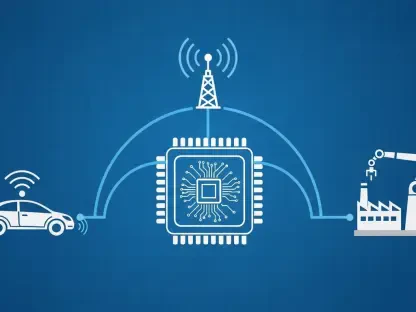Imagine a world where mobile networks adapt instantly to user demands, delivering seamless connectivity even in the most crowded urban hubs or remote rural areas, transforming the way we communicate and interact with technology. This vision is becoming reality through the integration of artificial intelligence into radio access networks, commonly known as AI-RAN. Spearheaded by KT, a leading South Korean telecommunications carrier, this technology promises to revolutionize how networks operate, enhancing 5G performance and paving the way for 6G systems. This review delves into KT’s pioneering trials, exploring the core features, real-world impact, and future potential of AI-RAN in transforming the telecom landscape.
Understanding AI-RAN and KT’s Trailblazing Efforts
AI-RAN represents a groundbreaking approach to telecommunications by embedding artificial intelligence into the core of radio access networks. This technology enables dynamic optimization of network resources, ensuring efficient data transmission and improved user experiences. At its essence, AI-RAN leverages machine learning and real-time analytics to address challenges like data loss and congestion, which have long plagued traditional networks.
KT stands at the forefront of this innovation as the first South Korean operator to test AI-RAN on a live 5G network. Conducted in Naju, South Jeolla Province, these trials mark a significant milestone in the global telecom industry. By pushing the boundaries of what current networks can achieve, KT is not only enhancing connectivity for its users but also setting a benchmark for competitors worldwide, demonstrating the transformative power of AI in mobile communications.
The importance of KT’s initiative extends beyond national borders, as it contributes to the broader discourse on network evolution. Collaborating with industry giants like Nokia, which provides advanced 5G base stations equipped with specialized AI processors, KT is driving a collaborative effort to refine and scale this technology. This positions the company as a key player in shaping the future of wireless systems.
Diving into KT’s AI-RAN Features
Channel Estimation Powered by Machine Learning
One of the standout features of KT’s AI-RAN technology is its use of machine learning for channel estimation. This process involves analyzing intricate radio wave patterns to predict and mitigate potential disruptions in data transmission. By doing so, the system significantly reduces data loss, ensuring more reliable connections for end users, even in challenging environments.
The impact of this feature on network performance cannot be overstated. In densely populated areas where interference is common, channel estimation helps maintain signal clarity, directly enhancing call quality and data speeds. KT’s pilot in Naju has shown promising results, with early data indicating a marked improvement in connection stability compared to conventional methods.
Moreover, this AI-driven approach adapts to varying conditions in real time, offering a level of flexibility that traditional systems lack. As networks face increasing demands from diverse applications like streaming and gaming, such adaptability becomes crucial. KT’s implementation highlights how machine learning can address long-standing issues, setting a new standard for reliability in telecommunications.
Multi-User MIMO for Superior Capacity
Another critical component of KT’s AI-RAN is multi-user MIMO, a technology that allows base stations to transmit data to multiple users simultaneously using the same frequency and time slot. This capability dramatically boosts network throughput, enabling more devices to connect without sacrificing speed or performance.
The reduction in latency achieved through multi-user MIMO is particularly noteworthy. Users experience faster response times, which is essential for applications requiring instant data transfer, such as augmented reality or autonomous vehicle systems. KT’s trials have demonstrated how this feature can handle high traffic volumes, ensuring stable connections during peak usage periods.
Beyond individual user benefits, this technology enhances overall network efficiency. By optimizing resource allocation, it minimizes congestion, a common bottleneck in urban settings. KT’s focus on multi-user MIMO underscores its commitment to building robust networks capable of supporting the growing demands of a hyper-connected world.
Trends Shaping AI in Mobile Networks
The integration of AI into telecommunications is rapidly gaining traction, with AI-RAN emerging as a pivotal technology for future mobile systems. Its ability to process traffic data in real time between base stations and servers allows for dynamic tuning of connections, ensuring optimal performance under varying conditions. This trend signals a shift toward smarter, more responsive networks.
As the industry moves toward 6G, AI-RAN’s role becomes even more critical. The anticipated demands of next-generation systems—such as ultra-low latency and massive connectivity—require innovative solutions that traditional architectures cannot provide. KT’s early adoption and testing of AI-RAN position it as a leader in preparing for these advancements, potentially influencing global standards.
Furthermore, the emphasis on real-time analytics reflects a broader movement within telecom to leverage data for strategic decision-making. By harnessing AI, operators can anticipate user needs and allocate resources proactively. KT’s efforts in this domain highlight how such trends are not just futuristic concepts but actionable strategies being implemented today.
Real-World Impact and Strategic Partnerships
KT’s AI-RAN pilot in Naju serves as a prime example of the technology’s real-world application. Supported by Nokia’s cutting-edge 5G base stations with embedded AI processors, the program tests the system’s ability to enhance network performance under live conditions. Initial feedback suggests significant improvements in both speed and reliability, validating the potential of AI-RAN.
Beyond this specific trial, KT is expanding its AI footprint through international collaborations. A notable partnership with Viettel Group, Vietnam’s largest carrier, focuses on advancing AI and digital transformation across Southeast Asia. This alliance targets the development of localized AI language models and industry-specific platforms, fostering a regional ecosystem for innovation.
Additionally, joint research with Viettel on AI-powered cybersecurity addresses pressing issues like voice phishing and deepfake threats. This comprehensive approach demonstrates KT’s vision of using AI not only for network optimization but also for societal benefits. Such collaborations amplify the impact of AI-RAN, showcasing its versatility across different domains and markets.
Navigating Challenges in AI-RAN Implementation
Despite its promise, the deployment of AI-RAN is not without hurdles. Technical complexities, such as integrating AI algorithms with existing infrastructure, pose significant challenges for KT. Ensuring compatibility across diverse hardware and software systems requires meticulous planning and substantial investment, which could slow down scaling efforts.
Regulatory considerations also play a critical role in the technology’s rollout. Compliance with national and international standards for data privacy and network security must be addressed to avoid potential setbacks. KT’s ongoing pilot in Naju serves as a testing ground to identify and resolve these issues before broader commercial adoption.
Furthermore, the need for extensive evaluation cannot be ignored. While initial results are encouraging, long-term performance under varied conditions remains unproven. KT must continue rigorous testing to build confidence in AI-RAN’s scalability and reliability, ensuring that it meets the high expectations set for modern telecommunications solutions.
Looking Ahead to 6G with AI-RAN
The future of AI-RAN holds immense potential, particularly as the telecom industry gears up for 6G systems over the coming years. This technology is poised to become a cornerstone of next-generation networks, offering the scalability and intelligence needed to support unprecedented connectivity demands. KT’s proactive stance in testing and refining AI-RAN ensures it remains at the cutting edge of this evolution.
Anticipated breakthroughs in AI capabilities could further enhance AI-RAN’s effectiveness, enabling features like predictive maintenance and autonomous network management. Such advancements would reduce operational costs while improving service quality. KT’s role in driving these innovations positions it as a key influencer in global network development.
Moreover, the long-term impact on user connectivity could be transformative. As AI-RAN matures, it promises to deliver seamless experiences across diverse applications, from smart cities to industrial automation. KT’s continued investment in this field signals a commitment to not just meeting current needs but also shaping a more connected future.
Final Thoughts on AI-RAN’s Journey
Reflecting on KT’s journey with AI-RAN, it is clear that the trials conducted in Naju marked a pivotal moment in telecommunications. The technology demonstrated substantial improvements in 5G network performance, addressing critical challenges through innovative features like channel estimation and multi-user MIMO. Partnerships with industry leaders like Nokia further strengthened the foundation for success.
Looking back, the strategic collaborations, such as with Viettel Group, showcased KT’s broader vision for AI beyond network optimization. These efforts highlighted a holistic approach that tackled regional digital transformation and cybersecurity threats. The challenges encountered during deployment underscored the importance of thorough testing and regulatory alignment.
Moving forward, the focus should be on expanding pilot programs to diverse environments to validate AI-RAN’s scalability. Stakeholders must prioritize developing standardized frameworks for integration and compliance to accelerate adoption. Additionally, investing in talent and research will be crucial to unlocking the full potential of AI-RAN, ensuring that the telecom industry continues to evolve toward greater efficiency and connectivity.









